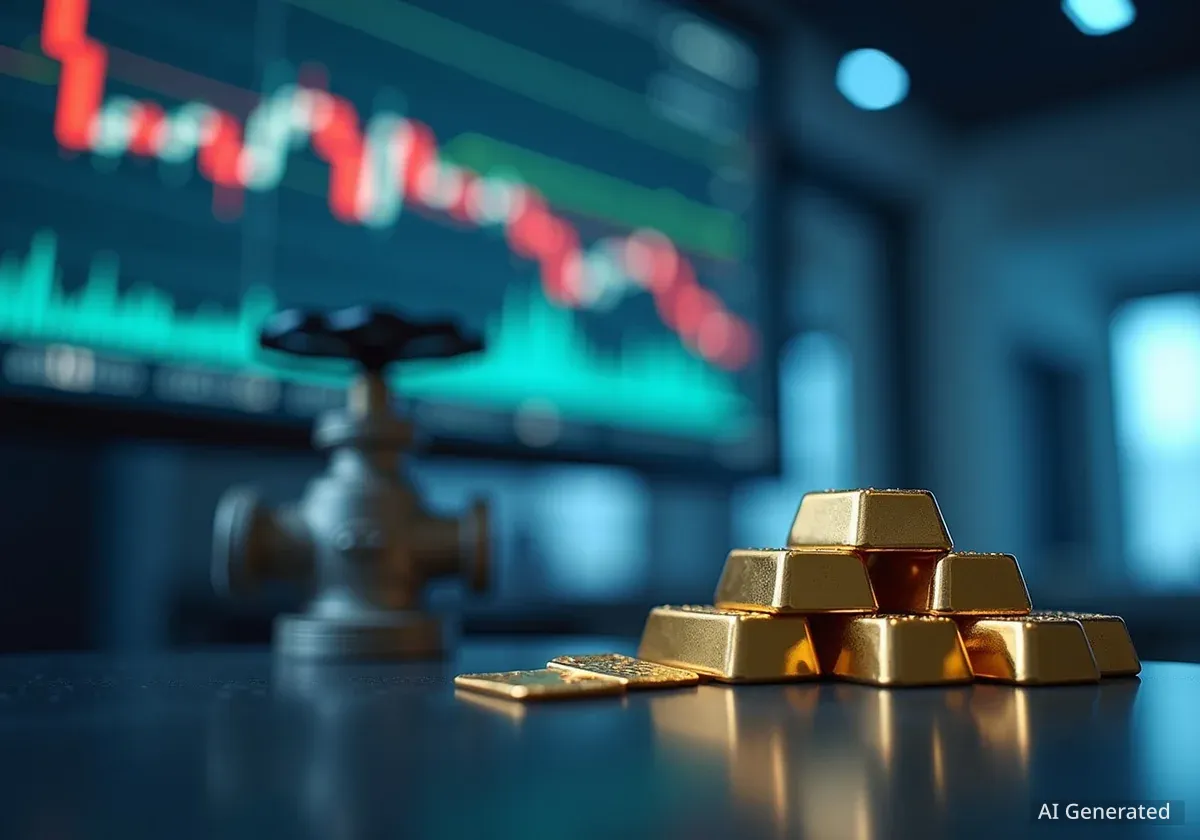The U.S. dollar is asserting its strength in global markets, climbing to new highs and placing significant pressure on precious metals. Gold, silver, and platinum prices have retreated as investors shift their focus toward the dollar, driven by changing expectations around Federal Reserve interest rate cuts.
In a separate but notable market movement, natural gas prices have surged, breaking through key technical levels. This rally is fueled by forecasts predicting colder weather, which would increase demand for heating fuel.
Key Takeaways
- The U.S. Dollar Index (DXY) has surpassed the 100-point mark, indicating broad strength against other major currencies.
- Gold prices have fallen by over 1%, with silver and platinum also experiencing significant declines.
- Market sentiment has shifted, with traders now scaling back bets on imminent interest rate cuts by the Federal Reserve.
- Natural gas prices have jumped more than 4% due to colder weather forecasts, signaling a potential breakout.
Dollar Rally Gains Momentum
The U.S. dollar has extended its recent rally, with the DXY index breaking through the psychologically important 100 level. This surge reflects a significant shift in investor sentiment, as expectations for aggressive interest rate cuts from the Federal Reserve begin to fade.
Strong economic data and cautious commentary from Fed officials have led traders to reconsider the timing and magnitude of potential monetary policy easing. As a result, the appeal of the dollar as a higher-yielding currency has increased, attracting capital and pushing its value up against counterparts like the Euro and the British Pound.
What is the DXY?
The U.S. Dollar Index (DXY) measures the value of the dollar against a basket of six major foreign currencies: the Euro (EUR), Japanese Yen (JPY), British Pound (GBP), Canadian Dollar (CAD), Swedish Krona (SEK), and Swiss Franc (CHF). A reading above 100 is generally considered a sign of a strong dollar.
The currency pair EUR/USD saw the Euro weaken by 0.30%, while GBP/USD showed an even steeper decline for the pound at 0.81%. Conversely, the dollar gained against the Canadian dollar, with USD/CAD rising by 0.26%. This broad-based strength highlights a 'risk-off' environment where investors seek the relative safety of the U.S. currency.
Precious Metals Feel the Weight of a Stronger Dollar
The rise of the dollar has created significant headwinds for precious metals, which are priced in the U.S. currency. When the dollar strengthens, commodities like gold become more expensive for buyers using other currencies, which typically dampens demand.
Gold (XAU/USD) experienced a notable retreat, falling by 1.05%. The yellow metal is now trading below key support levels as investors weigh the opportunity cost of holding a non-yielding asset like gold when returns on dollar-denominated assets are more attractive.
Market Performance Snapshot
- Gold (XAU/USD): -1.05%
- Silver (XAG/USD): -0.78%
- Platinum: -1.52%
- U.S. Dollar Index (DXY): Surpassed 100
Silver (XAG/USD) also faced downward pressure, dropping 0.78% and trending toward its 50-day moving average. This technical indicator is often watched by traders as a potential sign of a continued bearish trend. Platinum saw the steepest decline among the major precious metals, falling by 1.52%.
Investor Outlook Shifts
The current bearish outlook for precious metals is directly tied to the revised expectations for central bank policy. Earlier sentiment pointed toward swift and substantial rate cuts from the Federal Reserve in 2024. However, with inflation remaining persistent and the labor market showing resilience, those bets are being unwound.
This recalibration means that interest rates may stay higher for longer, further bolstering the dollar and making assets that do not offer a yield, such as gold and silver, less appealing to investors seeking returns.
Natural Gas Breaks Out on Weather Forecasts
While precious metals declined, the natural gas market moved sharply in the opposite direction. Prices for natural gas surged by over 4%, driven by meteorological forecasts pointing to a period of colder weather across key consumption regions.
This price jump pushed natural gas above its 200-day moving average, a significant technical milestone that could signal a potential breakout and a shift in the medium-term trend. Colder temperatures directly translate to increased demand for heating, which can quickly draw down inventories and support higher prices.
The market had previously seen a slight pullback, but the updated weather outlook provided a strong catalyst for buyers to enter the market. The move highlights the inherent volatility of energy commodities, which are often highly sensitive to short-term factors like weather patterns, in contrast to the macroeconomic drivers affecting precious metals.
As traders analyze the charts, the key question is whether this breakout can be sustained. Continued cold weather and a corresponding increase in demand will be crucial for natural gas to maintain its upward momentum in the coming weeks.





